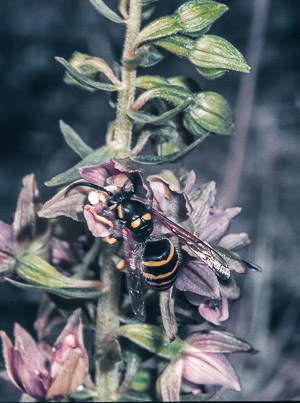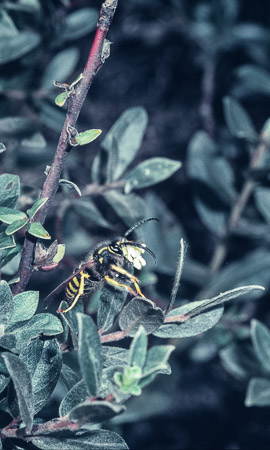

On 15-8-1986, in the "Neerlandica-valley", at the peak of subsp. neerlandica flowering time, a wasp was observed visiting an flowering stem. The wasp was subsequently identified from a slide as a male Dolichovespula saxonica or D. sylvestris. Although the flowers had all already lost their rostellum and pollinia, the wasp nevertheless visited many of them, often more than once. The wasp had collected many pollinia on its head, which it occasionally tried to remove in vain. The wasp then flew against the wind (force 5-6) to a neighbouring plant. Later, three other plants standing close together were visited and the first two plants were revisited at least twice at some length. The plants were always approached against the wind and in a straight line, apparently without searching for them.
On 28-8-1988 a wasp was caught on a specimen of subsp. neerlandica at a newly discovered site. After identification it proved to be a male Dolichovespula saxonica. On the same day a bumblebee (Bombus spec.) was observed on a subsp. neerlandica growing near the first site in an isolated stand of Creeping Willow. It visited several flowers and apparently took nectar, but no pollinia became attached to its head.
 |  |
On 14-8-1988, in a rather open pine wood, a wasp was observed perching on a subsp. neerlandica leaf with a pair of pollinia on its head. The wasp was identified as a male Dolichovespula species. Although the wasp was sitting motionless, it was not certain that it was "intoxicated".
On 28-8-1988 several wasps were again observed visiting subsp. neerlandica in the same pine wood. One of these wasps was observed drinking on the edge of a concrete water channel and had pollinia on its head. Later, a wasp caught while visiting the subsp. neerlandica was subsequently identified as Dolichovespula saxonica. None of the wasps observed on this day seemed even slightly intoxicated. Finally, a small, oblong, dark green shiny beetle was observed on some neerlandica flowers in quick succession but took away no pollinia.
On 8-8-1988 a wasp (Vespula or Dolichovespula spec.) was seen visiting a large neerlandica. The wasp flew quickly away and could not be caught for identification. A bumblebee (Bombus spec.) was also observed visiting another large plant three times and a smaller one once. The bumblebee seemed to suck nectar, but remained at a distance from the rostella and carried away no pollinia on its head or tongue. Five days later, however, there appeared to have been so many visits of other insects, that most of the flowers no longer had a rostellum. On 18-8-1988 another bumblebee visit was observed and again it neither took away any pollinia.